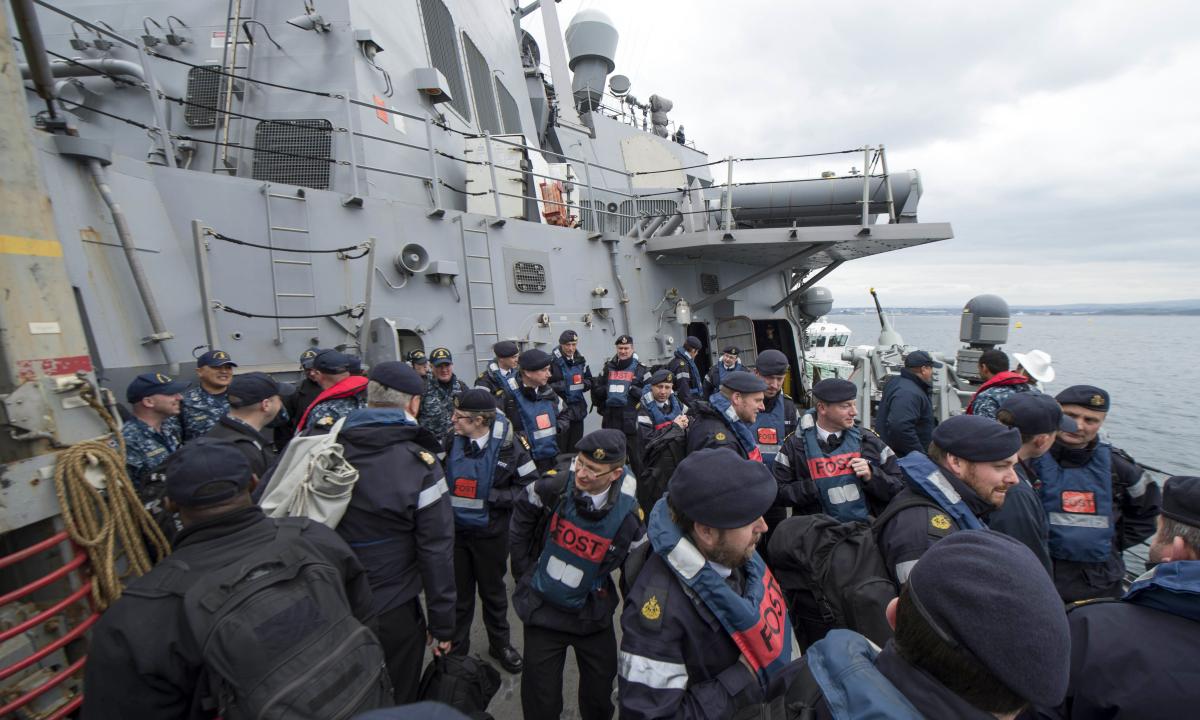In 2017, the USS Carney (DDG-64) participated in the British Royal Navy’s Flag Officer Sea Training (FOST), which was created in 1958 to ensure that nation’s crews and commanding officers were fully trained to fight their ships in the most extreme conditions. In today’s FOST, British ships endure six weeks of training that grows in intensity, incorporating a weekly simulated war that stresses battle messing, command of a task group, air defense, critical engineering casualties, and catastrophic structural damage control. U.S. forward-deployed destroyers in Rota, Spain, complete a three-week version of FOST tailored to their training needs in Plymouth, England, and in the waters to its south.
FOST Is More Effective Than U.S.-Based Training
The FOST organization is well staffed and sends approximately 50 top-notch assessors and trainers to a single ship each day of training on the FOST range. This number is far greater than what the U.S. Navy’s Afloat Training Group provides during similar training evolutions. It is also far different from U.S. strike groups’ composite training unit exercises (CompTuEx), which focus on the staff’s ability to manage and fight its force. Strike group units enter CompTuEx already certified at the basic unit level, while FOST, which has submarines and aircraft equipped with jamming pods, is set up to train ships at the unit level in every major surface warfare area.
Because FOST trains many foreign navies, primarily from NATO countries, any given week provides a rich training ground of different capabilities and experience. For ships that usually deploy independently from strike groups, such as the Rota-based destroyers, FOST is an unmatched resource that combines unit-level and task-group-level training into one program. In the U.S. Navy, surface warfare advanced tactical training was recently instituted using warfare tactics instructors who embark during war-at-sea exercises. This represents a small step closer to the experience that FOST provides, but is still far below the level of instructor attention that a ship at FOST receives.
The Command Advisor Program
Information is the most important weapon, and its smart collection, organization, and dissemination increases the commanding officer’s ability to command a ship during large-scale operations or emergencies. A U.S. ship at general quarters does not have a central node to receive, deconflict, and tailor information for the commanding officer. The tactical action officer (TAO), officer of the deck, and engineering officer of the watch make individual reports to the commanding officer as needed. By contrast, a Royal Navy ship at general quarters designates an officer as the “command advisor” to assimilate critical information reported from around the ship and to provide the commanding officer with clearer reports as to what’s happening on the ship, information that is necessary to command in crisis.
As a department head and qualified TAO, the ship’s operations officer is a natural fit for the command advisor position. Indeed, the British Navy taps operations officers for this role and sends them to a formal command advisor school.
The command advisor positions a team of dedicated watchstanders at strategic locations throughout the ship. They collect and assign relative value to information, allowing the regular ship watchstanders to focus on operating equipment and responding to casualties. This ensures the command advisor gets the necessary information in a timely manner, without affecting the operation of the ship.
Other than the command advisor, this team consists of an assistant, the chief engineer, and a combat systems advisor. The command advisor assistant receives and organizes the incoming information. The chief engineer delivers engineering plant status updates via handheld radio. The combat systems advisor manages and reports the material status of the equipment, which means the combat systems coordinator is able to focus exclusively on the tactical fight in a combat scenario. The few additional watchstanders needed at general quarters are well worth the added benefit of quick information organization and dissemination to the commanding officer.
How FOST Helped the Carney
While FOST did not require it, the Carney chose to implement the command advisor program during its three-week training visit. FOST pushed the Carney beyond its comfort zone through a scenario in which submerged container boxes punctured holes in the hull below the waterline. This was a devastating situation that required the ship to transition rapidly from routine steaming to general quarters for damage control. To begin gathering and passing clear, concise, and actionable information to the commanding officer, the command advisor team was formed. The scenario stressed the need to comprehend the extent of damage and immediate actions that the Carney could and should take. Was there a safe port close enough for the ship to enter? Were crew members in need of medical evacuation? In a noncombat damage-control scenario, these were the highest priority questions.
After FOST, the Carney codified the command advisor program in the commanding officer’s battle orders and standing orders. A few months later, the command advisor team was formed during an engineering certification event after a watchstander accidentally tripped a generator offline, leaving the ship dark and without power. Initial information reports were disorganized and confusing, but the command advisor team soon was able to assemble a clearer picture for the commanding officer. The FOST program was invaluable and would have been even more critical if a similar engineering casualty had occurred while the Carney was operating in more dangerous waters, as it was when conducting naval gunfire support in Libyan territorial waters during Operation Odyssey Lightning.
FOST not only provided the destroyer with the most intense training the crew had ever undergone, it also introduced the wardroom to a different and very effective way to manage information flow during combat. The U.S. surface navy would benefit greatly from getting as many ships as possible to FOST each year and from implementing the command advisor program throughout the fleet.



